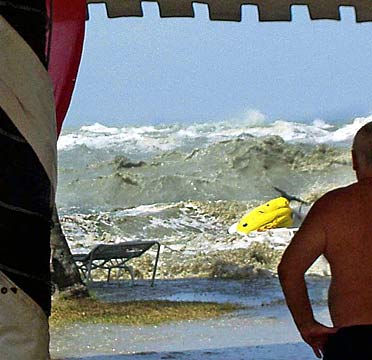
|
Tsunamis cast light
on disaster planning
Hawaii briefs
Chaos descends on disaster zone
Hickam workers to help with victims.
W.Coast wave could beat mainland warning
HONOLULU » The severity of global disasters such as this week's massive Asian tsunamis could be lessened with planning, but developing countries are too often unwilling to spend the money needed, a development and disaster management expert said yesterday.
Although putting such systems in place could save hundreds if not thousands of lives, it requires spending upfront, said Allen Clark, a senior research fellow at the East-West Center.
"Very few governments, when faced with the alternatives for expending their revenue, will choose to expend it on something that might happen and where you might protect people," he said.
Clark was among the experts from Hawaii and 16 Pacific nations and territories who gathered in Honolulu in June to study how Pacific Rim nations can better prepare for and prevent damage from natural disasters.
Clark plans to present some of the findings from the Pacific Health Summit for Sustainable Disaster Risk Management at a similar U.N. conference, the World Summit on Disaster Reduction scheduled for Jan. 17-21 in Kobe, Japan.
Although the discussions come too late to help the Asian and African nations coping with the tsunamis generated by the magnitude-9.0 earthquake in Indonesia on Sunday, Clark said the world summit -- like the Hawaii meetings -- will study ways to prevent future large-scale tragedies.
The key to surviving disasters is preparedness, which includes taking steps aimed at lessening the effects of the disaster, Clark said.
A key part of preparedness is having an early-warning system in place.
Although an international warning system for tsunamis began in 1965, India and Sri Lanka, hit hard by this week's catastrophe, are not among the 26 countries that participate.
Officials at the federal government's Pacific Tsunami Warning Center in Ewa Beach have said they were able to predict the possibility of a tsunami after Sunday's earthquake in Indonesia but were unable to quickly relay a warning to the countries outside the international warning system.
Experts have renewed calls for a global surveillance system to detect and forecast disasters like tsunamis, and U.N. officials say the world summit will have a special session to lay the groundwork to extend the tsunami warning system beyond the Pacific Ocean.
Clark recommends the focus be on creating a single, multihazard warning system, rather than separate systems for different types of disasters.
Pacific quake
zone poses risk
Scientists fear tsunami damage in
any encore to a 1700 earthquake
off the West Coast
Tsunami scientists and public safety officials are closely watching an earthquake-prone nation with thousands of miles of crowded coastlines for signs of an imminent disaster.
Indonesia? Japan? Try the United States.
Experts say the West Coast could experience a calamity similar to the one they have been watching unfold half a world away.
"People need to know it could happen," said geologist Brian Atwater, of the U.S. Geological Survey.
Scientists say grinding geologic circumstances similar to those in Sumatra also exist just off the Pacific Northwest coast. They are a loaded gun that could trigger a tsunami that could hit Northern California, Washington, Oregon and British Columbia in minutes -- too fast for the nation's deep-sea tsunami warning system to help.
In fact, Atwater said there was a 9.0 earthquake under the Pacific more than 300 years ago that had devastating consequences. He and other scientists last year reported finding evidence of severe flooding in the Puget Sound area in 1700, including trees that stopped growing after "taking a bath in rising tide waters."
The danger rests just 50 miles off the West Coast in a 680-mile undersea fault known as the Cascadia subduction zone which behaves much like one that ruptured off Sumatra. The 1700 quake occurred along the Cascadia fault.
Scientists say a giant rupture along the fault would cause the sea floor to bounce 20 feet or more, setting off powerful ocean waves relatively close to shore. The first waves could hit coastal communities in 30 minutes or less, according to computer models.
Seattle; Vancouver, British Columbia; and other big cities in the region probably would be relatively protected from deadly flooding because of their inland locations. But other, smaller communities could be devastated.
And while buildings in the United States are far more solid than the shacks that were obliterated in some of Asia's poor villages, few structures could withstand nearby tremors as powerful as those that occurred Sunday in Sumatra.
Moreover, such a quake would be way too close to shore for the nation's network of deep-sea wave gauges to be of any help.
Even in the case of quakes happening farther out in the Pacific or in Alaska, the U.S. warning system might not be adequate.
The network -- which consists of six deep-sea instruments in Alaska, Washington, Oregon and Hawaii and near the equator off the coast of Peru -- is thin and scattered, and at least two of the gauges in Alaska are not even reporting daily wave readings. Also, predicting where a tsunami is likely to come ashore cannot be done with the kind of precision seen in hurricane forecasts.
Eddie Bernard, who directs the network for the National Oceanic and Atmospheric Administration, said the six sensors are the "bare minimum" for adequate warning. He said there are plans to expand the system to 20 sensors in the next five years, including 10 gauges for the seismically active Aleutian Islands.
Whether the continental United States is vulnerable to tsunamis from Asian earthquakes is another question. Hawaii and parts of Alaska certainly are exposed, but whether earthquake fault lines in Japan and Southeast Asia are oriented in the right directions to send tsunamis all they way to the mainland is debatable.
As for the Atlantic Coast, a tsunami is considered extremely unlikely.
[News] [Business] [Features] [Sports] [Editorial] [Do It Electric!]
[Classified Ads] [Search] [Subscribe] [Info] [Letter to Editor]
[Feedback]
